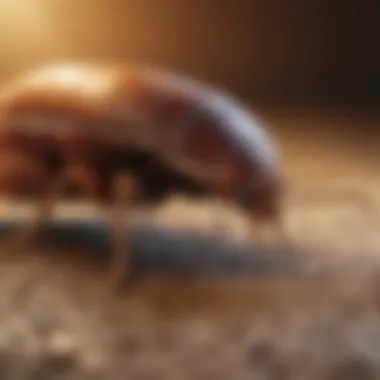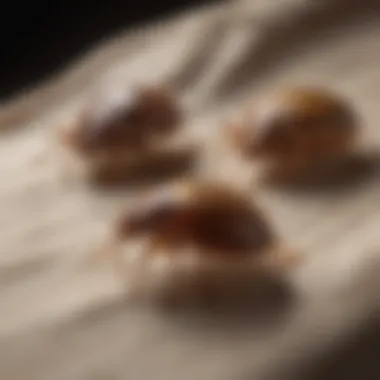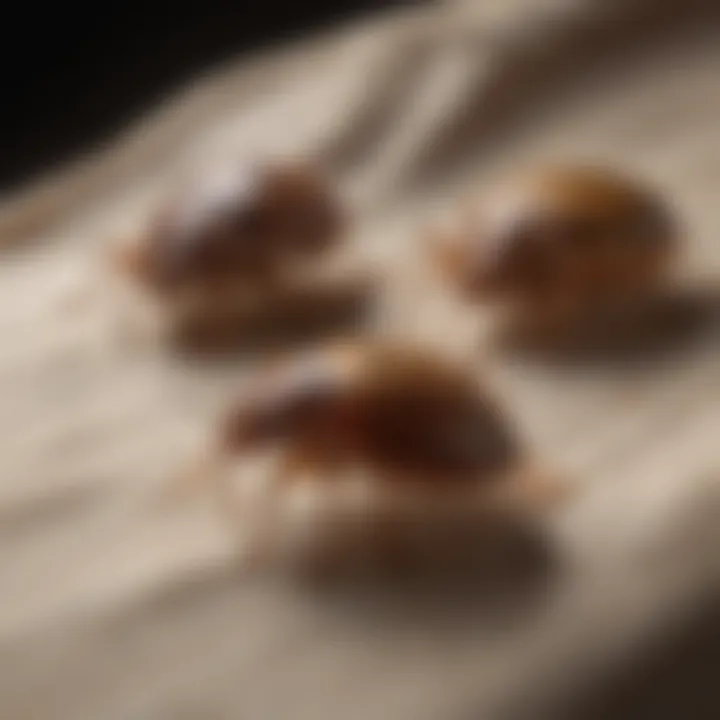Understanding Bed Bug BBQ: Risks & Management


Intro
Bed bugs have become a significant concern for many homeowners. Their presence often leads to discomfort, anxiety, and a range of health issues. As awareness about the persistence of these pests grows, effective management and control strategies take on paramount importance. One such method that has stirred interest and debate is heat treatment, commonly known as bed bug BBQ. Understanding the nature of these pests and the implications of various control methods is essential for both immediate and long-term management.
Understanding the Pest
Identification
Bed bugs, scientifically referred to as Cimex lectularius, are small, wingless insects. Adult bed bugs are approximately the size of an apple seed, with a flat, reddish-brown body that swells after feeding. Their most notable feature is their ability to hide in small crevices, making detection challenging. A common mistake is confusing bed bugs with other similar-looking insects, such as carpet beetles or bat bugs. However, a meticulous examination can distinguish these pests.
Key signs of a bed bug infestation include:
- Bite Marks: Red, itchy welts often appear in a line or cluster on exposed skin.
- Fecal Stains: Small, dark spots on sheets or mattresses may indicate the presence of these pests.
- Shed Skins: As bed bugs mature, they shed their exoskeletons, which can be found near infested areas.
Life Cycle
Understanding the life cycle of bed bugs is crucial for effective management. Bed bugs go through five nymph stages before becoming adults. Each nymph stage requires a blood meal to progress to the next. The entire cycle, from egg to adult, can take anywhere from six weeks to several months, depending on environmental conditions like temperature and humidity.
- Eggs: Tiny and white, laid in clusters.
- Nymphs: Hatched bed bugs that are small and translucent initially.
- Adults: Capable of reproduction and can live several months without feeding.
Pest Prevention Strategies
Environment Modification
Preventing bed bugs starts with understanding their preferred habitat. These pests thrive in environments that provide warmth and easy access to human hosts. To reduce the risk of infestation:
- Declutter: Minimize clutter in bedrooms and living areas to reduce hiding spots.
- Inspect Second-hand Items: Thoroughly examine furniture and clothing before bringing them into the home.
- Regular Cleaning: Frequent vacuuming and cleaning can help limit the chances of bed bugs settling in.
Physical Barriers
Using physical barriers can effectively prevent bed bugs from entering sleeping areas. Consider:
- Bed Covers: Encase mattresses and box springs with specially-designed bed bug proof covers.
- Seal Cracks and Crevices: Use caulk to seal potential entry points where bed bugs might hide.
- Monitor Devices: Employ bed bug interceptors under bed legs to trap and monitor bed bug activities.
Control Methods
Chemical Control
Chemical pest control remains one of the more common approaches to manage bed bug populations. Various insecticides are formulated specifically to target these pests. However, caution is necessary:
- Follow label instructions carefully.
- Be aware of potential resistance to commonly used chemicals.
- Consider hiring professionals who understand the nuances of chemical applications.
Biological Control
An emerging method involves biological control strategies. These include:
- Natural Predators: Certain insects, like the Entomopathogenic nematodes, can prey on bed bugs.
- Integrated Pest Management (IPM): This combines biological solutions with traditional methods, reducing the reliance on chemical treatments.
"A proactive approach toward pest management, focusing on prevention and sustainable methods, is often more effective in the long run."
Finale
Understanding bed bugs and their management requires a blend of knowledge, awareness, and the application of effective strategies. Whether opting for chemical methods, biological controls, or simple prevention measures, being informed is the first step in resolving issues related to these pests. As you navigate your pest management efforts, consider both the immediate needs and the broader environmental implications of your choices.
Intro to Bed Bugs
Understanding bed bugs is crucial when addressing infestations and the various management strategies available. Bed bugs are tiny pests that can significantly impact the quality of life in affected homes. Their presence often leads to discomfort and can have psychological effects on those suffering bites and sleep disturbances. Therefore, recognizing the importance of bed bugs and their management offers several benefits. Firstly, it equips homeowners with knowledge about early signs of infestation, enabling proactive action. Secondly, understanding their lifecycle is essential for effective treatments, particularly when considering methods like heat treatment.
Defining Bed Bugs
Bed bugs, scientifically known as Cimex lectularius, are small, wingless insects that feed on the blood of humans and animals. They are typically reddish-brown and can vary in size but generally have a flat, oval shape. These insects are most active at night, making them challenging to detect until significant infestations occur. Their ability to reproduce quickly compounds infestation issues, making early detection vital.
The Lifecycle of Bed Bugs
The lifecycle of bed bugs consists of three main stages: egg, nymph, and adult. Each stage presents distinct characteristics and impacts on the overall management of bed bug outbreaks.
Egg Stage
The egg stage of bed bugs is a critical point in their lifecycle. Female bed bugs can lay anywhere from one to five eggs per day, leading to rapid population growth. Each egg is about 1mm in size and typically white or translucent, making them difficult to spot. The high fecundity of bed bugs contributes significantly to their resilience against extermination efforts. Understanding this stage is beneficial, as it highlights the need for thorough inspections and appropriate treatments to target eggs effectively.
Nymph Stage


Nymphs are the immature stages of bed bugs that undergo several molts before reaching adulthood. They require a blood meal at each stage of development, which occurs typically every few days. Nymphs are smaller than adults, generally resembling them but being less than half the size. Identifying this stage is crucial for a comprehensive treatment plan, as nymphs also contribute to the infestation. Their presence signifies an active and ongoing issue that needs addressing to prevent further population growth.
Adult Stage
Adult bed bugs are about the size of an apple seed and are easier to identify than their younger counterparts. They are capable of traveling long distances in search of food, which increases the likelihood of spreading to other areas. Adult bed bugs can live for several months without feeding, making them particularly tenacious pests. Recognizing the adult stage is key in any control strategy, as their presence often indicates a more serious infestation that requires immediate attention.
"Understanding each stage of the bed bug lifecycle aids in developing more effective management strategies and helps prevent future infestations."
In summary, a thorough understanding of bed bugs, including their definitions and lifecycle stages, is essential for effective management and control strategies. Recognizing these details not only aids in identifying current infestations but also helps prevent future occurrences.
Understanding Bed Bug Infestations
Understanding bed bug infestations is critical for effective pest management. This knowledge leads to timely interventions that can limit the physical and psychological toll these pests inflict. Infestations can rapidly escalate, making early detection vital. By grasping the signs and characteristics of infestations, homeowners can safeguard their living spaces and avoid costly remedies. Moreover, lessons learned from identifying these pests not only assist in individual cases but also contribute to broader solutions in pest control.
Identifying Signs of Infestation
Physical Evidence
Physical evidence forms the cornerstone for confirming bed bug infestations. Key characteristics of this evidence include small, rust-colored stains on bedding or furniture. These stains originate from digested blood and serve as a clear signal of a potential problem. Detecting these stains early is beneficial since it allows for prompt action.
Moreover, adults, nymphs, and discarded exoskeletons represent unique features of physical evidence. Recognizing these can significantly enhance the early detection strategy. If physical signs are ignored, infestations may worsen, leading to a more complex and costly eradication process. Homeowners should actively look for these indicators to maintain a pest-free environment.
Behavioral Indicators
Behavioral indicators also play a pivotal role in identifying infestations. These include emerging signs like disrupted sleep patterns or unexplained bites on skin. Key characteristics of these behavioral changes may include increased anxiety or stress, often connected to the presence of bed bugs. Such behavioral responses serve as important clues for homeowners, signaling potential infestations.
One unique feature of behavioral indicators is their ability to highlight the psychological impact of bed bugs. The stress they cause can lead to insomnia or emotional distress, which are often overlooked aspects of pest problems. Staying attuned to these signs is essential for effectively addressing infestations and improving overall well-being.
Common Myths Surrounding Bed Bugs
Bed bugs are subject to numerous myths. One prevalent myth is that bed bugs only inhabit dirty environments. In truth, they can thrive in clean spaces as well; their primary requirement is proximity to humans. Another common misconception is that bed bugs transmit diseases. While they do cause discomfort, there is no evidence linking them to disease spread. Dispelling these myths is crucial for fostering an informed approach to pest management. Understanding what bed bugs are and how they behave ensures homeowners can make smarter, evidence-based decisions in managing infestations.
Preface to Bed Bug BBQ
Understanding bed bug BBQ is crucial for effective pest management and for anyone dealing with these resilient insects. This section will shed light on what it entails, providing clarity to homeowners facing infestations. Since the awareness of bed bugs has risen, many seek solutions that address their immediate concerns while considering health, safety, and environmental impacts.
What is Bed Bug BBQ?
Bed bug BBQ, a term used to describe heat treatment for bed bug extermination, leverages high temperatures to eradicate the pests at various life stages. When heat is applied at specific temperatures, it can kill bed bugs effectively, making it a popular method in pest control. This method is appealing as it reduces the reliance on chemical insecticides, which can pose health risks for humans and pets. The process involves raising the temperature in the affected area to about 120–140 degrees Fahrenheit for a sustained period of time, typically around 90 minutes or more, depending on the level of infestation and the materials involved.
Using this technique comes with several advantages. It provides thorough coverage, as heat penetrates even the hardest-to-reach places. It is also environmentally friendlier compared to traditional chemical treatments. However, it necessitates meticulous planning and execution to prevent property damage or injury.
Historical Context of Heat Treatment
Heat treatment has a storied history in pest control, dating back to ancient civilizations. Though less common during the mid-20th century due to the advent of chemical pesticides, heat methods have resurfaced recently due to the growing bed bug crises worldwide. Pesticide resistance in bed bugs has made heat treatment an attractive alternative.
In the late 1990s, as bed bug populations surged in urban areas, professionals began to explore heat as a viable eradication method. The transition from chemicals to heat can be attributed to increased awareness of the side effects associated with prolonged chemical exposure. Now, this method continues to evolve, becoming more sophisticated with technology advancements, such as thermal imaging and specially designed heating equipment to ensure efficacy.
The Science Behind Heat Treatment
Understanding the science behind heat treatment, particularly in the context of bed bugs, is essential for effective management strategies. Heat treatment, often referred to as "bed bug BBQ," uses elevated temperatures to eradicate these pests. The significance of this method lies not just in its ability to kill bed bugs but also in how it contrasts with other extermination techniques. Evaluating these processes informs homeowners about the risks and benefits that are implicit in pest management.
How Heat Affects Bed Bugs
Temperature Ranges
Temperature ranges play a critical role in the effectiveness of heat treatment. Bed bugs and their eggs can withstand temperatures below 113°F (45°C) but become vulnerable once temperatures rise above this threshold. To effectively kill bed bugs, a heat range between 118°F (48°C) and 122°F (50°C) for a minimum of 90 minutes is typically recommended. This specific range is favored as it ensures that both adults and their eggs are eradicated, allowing for more complete pest control.
One unique feature of temperature ranges in heat treatment is that they can penetrate various materials, such as mattresses, furniture, and even wall crevices. However, a significant disadvantage is that improper temperature management can lead to damage. For instance, certain delicate objects could warp or melt if exposed to excessive heat.
Exposure Times
Exposure times are another critical aspect of heat treatment. Simply raising the temperature is not enough; sustained exposure is needed to ensure complete extermination of bed bugs. Research indicates that bed bugs require exposure to the lethal temperature for a minimum of 60 to 90 minutes to ensure effectiveness.
The distinct characteristic of exposure times in this method is their ability to vary. Factors such as room size and the density of infested items can influence how heat is distributed. This variability can lead to inconsistent results if not carefully monitored. Additionally, prolonged exposure can lower the overall success of the method if it leads to damage to the items or structures being treated.
Effectiveness of Bed Bug BBQ
Success Rates
The success rates of heat treatment methods, including bed bug BBQ, are notable. Many pest control professionals report effectiveness rates exceeding 90%, making it a popular choice for eradication. The high success rate is largely due to the ability to target all life stages of the bed bug, including resilient eggs.


However, one downside is that success rates can be influenced by the thoroughness of the treatment plan and the conditions of the environment. Areas that are difficult to reach, such as behind appliances, may not reach the effective temperature, resulting in potential reinfestation.
Comparison with Other Methods
In comparison with chemical treatments, bed bug BBQ has distinct advantages and disadvantages. Chemical methods often require multiple applications and can pose health risks to humans and pets if not used correctly. On the other hand, heat treatment is a one-time process, offering a more immediate solution.
However, the downside of heat treatment is the upfront cost, which can be higher than conventional chemical approaches. Additionally, it may not address bed bug issues in locations that are difficult to heat sufficiently, raising concerns about overall effectiveness.
In summary, while bed bug BBQ is a formidable option for pest control, it requires careful consideration of temperature levels, exposure times, and environmental conditions to maximize effectiveness.
Implementation of Bed Bug BBQ
Effective implementation of bed bug BBQ is essential for both pest control professionals and homeowners. Understanding how heat treatment works can lead to successful eradication of bed bugs, preventing further infestations. Many individuals express concern about the risks associated with heat treatment. However, the benefits often outweigh these risks, particularly when proper protocols are in place.
Professional Heat Treatment Services
Professional services provide expert knowledge and tools necessary for safe and efficient heat treatment. These experts are trained in identifying the optimal temperature for lethality against bed bugs. Additionally, they can ensure that every infested area is sufficiently heated.
Hiring a professional offers several advantages:
- Thoroughness: Professionals tend to cover more areas effectively than a DIY approach due to their equipment and experience.
- Safety: Trained experts understand how to implement heat without causing damage to property or health.
- Time-saving: Professional services usually require fewer hours than self-implemented techniques.
DIY Heat Treatment Techniques
DIY techniques offer homeowners an alternative to professional services. These methods typically involve the use of household items to create heat. However, effectiveness can be variable depending on the method and format used. Thus, it is crucial to understand both their limitations and potentials.
Home Appliances and Limitations
Using home appliances can seem appealing for DIYers. Items such as a clothes dryer, steam cleaners, or portable heaters can be used to target specific areas. A key characteristic of this option is accessibility; most homeowners possess these tools.
However, limitations are notable:
- Inadequate Heat: Many appliances do not reach the necessary temperatures throughout the entire infested area.
- Potential Damage: Improper use can lead to damaging personal items or property.
Ultimately, while using home appliances is a cost-saving option, their effectiveness may not compare with professional methods.
Safety Considerations
While implementing bed bug BBQ, safety is of utmost importance. Heat treatment can result in hazards if significant care is not taken. Therefore, awareness of these considerations is essential. A paramount feature of safety in this context is the need for adequate monitoring. Continuous observation of temperatures helps prevent fires or other damage.
Some key safety measures include:
- Ventilation: Ensure that spaces are well-ventilated to avoid carbon monoxide buildup.
- Protection of Electronics: Remove or shield sensitive electronics from excessive heat.
Addressing safety concerns ensures that an exploration of heat treatment methods remains beneficial. By focusing on both efficacy and safety, homeowners can feel confident in their pest management choices.
Risks and Considerations
Understanding the risks and considerations associated with bed bug BBQ is essential for anyone dealing with infestations. The methods you choose to manage bed bugs can have significant implications, not just for your property but also for your health and safety. As such, being well-informed enables homeowners to make decisions that mitigate risks while effectively addressing the problem.
Potential Property Damage
One of the foremost concerns about implementing bed bug BBQ is potential damage to your property. Heat treatment aims to eradicate bed bugs by raising the temperature within the affected areas. However, not all materials can withstand extreme heat.
- Heat-sensitive items: Items such as electronics, artwork, and certain fabrics may be vulnerable to high temperatures. It is crucial to remove these from the treatment area before applying heat. Improper management could lead to irreversible damage, resulting in costly replacements.
- Structural integrity: Wood and other materials might react negatively to prolonged exposure to high temperatures. In some cases, this could weaken the structural foundation of your property.
- Thermal expansion: Similar to how materials expand in extreme cold, they can also expand during high heat. This may cause damage to plaster, drywall, and paint. Homeowners should weigh these risks against the potential benefits of a thorough heat treatment.
To minimize the likelihood of damage, homeowners should consider consulting with pest control experts. They can assess the property and recommend precautions, ensuring that valuable items are protected during treatment.
Health and Safety Concerns
Another critical aspect of bed bug BBQ involves health and safety. While heat treatment is generally recognized as a relatively safe method for bed bug eradication, there are still considerations that should not be overlooked.
- Heat exposure: Prolonged exposure to high temperatures can be uncomfortable and even dangerous for humans and pets. Ensuring that everyone vacates the premises during treatment is paramount. It protects them from overheating and reduces risks associated with odors released during the process.
- Smoke inhalation: In cases where the heat treatment is not managed properly, smoke can accumulate. This poses risks of respiratory issues, especially for those with pre-existing conditions. Proper ventilation should be established before initiating treatment.
- Chemical residues: If heat treatment is combined with other pest control methods, there may be health concerns regarding the residues left behind from those chemical treatments. It is vital to understand what has been used and ensure that the space is safe to re-enter afterward.
"Effective management of bed bugs requires attention to potential risks, ensuring both property and resident safety during the eradication process."
Environmental Impact of Bed Bug BBQ
The environmental implications of employing heat treatment methods, often referred to as "bed bug BBQ," are crucial to consider. As the world increasingly faces ecological challenges, understanding how pest management practices affect our surroundings becomes paramount. The use of heat to exterminate bed bugs offers certain advantages over traditional pesticide methods; however, it is not without its drawbacks and ramifications in terms of energy use and broader environmental concerns.
While heat treatment effectively eradicates bed bugs, it requires substantial energy consumption, thereby contributing to a higher carbon footprint. This section will explore two main elements of the environmental impact associated with bed bug BBQ: energy consumption and alternatives to chemical treatments, both pivotal in structuring an environmentally-conscious pest management strategy.


Energy Consumption and Carbon Footprint
The process of heat treatment involves raising the temperature of infested areas to eliminate bed bugs. This requires significant electricity or natural gas resources, particularly in large spaces or heavily-infested environments. Factors such as the size of the area, the heat source, and the duration of the treatment can all influence the total energy required.
Key aspects to consider in term of energy consumption include:
- The type of heating equipment used: Electric heaters may use more energy, while propane options could introduce other environmental concerns.
- Duration of exposure: Longer exposure times increase energy demands.
- Conditioning of the structure: An ill-insulated area can lead to heat loss, thus requiring even more energy to achieve target temperatures.
The resultant carbon footprint from these operations must be acknowledged. The energy consumption leads to greenhouse gas emissions, contributing to climate change. Therefore, when evaluating heat treatment as a method of pest management, one must weigh the benefits of effective eradication against its environmental costs. Employing energy-efficient practices and developing more sustainable methods of pest control can help mitigate these effects.
Alternatives to Chemical Treatments
Given the environmental concerns associated with heat treatment, it is essential to explore alternative pest management techniques. These alternatives often emphasize a less resource-intensive approach to controlling bed bug populations while safeguarding the environment.
Some notable alternatives include:
- Integrated Pest Management (IPM): This involves using a combination of biological, cultural, and mechanical methods, rather than relying solely on one approach. IPM focuses on long-term prevention of pests through habitat modification and careful monitoring.
- Thermal Remediation: In some cases, employing more efficient thermal technologies could reduce overall energy usage while maintaining effectiveness. These include specialized heaters that target specific areas while using less energy.
- Natural Repellents: Utilizing substances that deter bed bugs, such as diatomaceous earth or essential oils, can provide a chemical-free option for pest control.
Employing these alternatives can contribute to a more sustainable pest management strategy that aligns with environmental goals, reducing reliance on both heat treatments and chemical pesticides.
Complementary Management Strategies
In the context of controlling bed bug infestations, complementary management strategies play a crucial role in enhancing the effectiveness of heat treatment, commonly known as bed bug BBQ. These strategies ensure that not only are the current infestations addressed, but future occurrences are prevented. Understanding these methods can help homeowners apply a more comprehensive approach to bed bug control, which is essential in reducing reliance on any one method while promoting long-term success.
Preventive Measures for Homeowners
Regular Inspections
Regular inspections are vital for residents seeking to maintain a bed bug-free environment. By routinely checking areas where bed bugs are likely to hide, such as mattress seams, bed frames, and upholstered furniture, homeowners can identify potential issues before they escalate. This proactive approach allows for early intervention, significantly reducing the likelihood of a full-blown infestation.
One key characteristic of regular inspections is their cost-effectiveness. Unlike pest control services, which can become expensive, these inspections require minimal investment—the homeowner’s time and effort. A unique feature of this method is that it promotes awareness of one’s living space. Homeowners become familiar with the signs of bed bugs, which may include small blood stains, shed skins, or black fecal spots. This heightened awareness enables a swift response to any signs of trouble.
However, while beneficial, regular inspections do require diligence and can be time-consuming. Homeowners must be disciplined in their approach, potentially leading to missed opportunities for early detection if neglected.
When Traveling
When traveling, bed bug awareness becomes especially important. Hotels and public transportation can serve as hotspots for infestations. Taking preventive measures during travel contributes to the larger goal of maintaining a bed bug-free home. A key aspect is simple—always inspect hotel rooms as soon as you enter, checking mattresses and luggage racks.
This proactive behavior is beneficial for minimizing risks, as it can help identify potential issues before they become problematic. Unique to this approach is the practice of using protective luggage covers or sealed bags to prevent bed bugs from hitching a ride back home. Such measures can significantly decrease the chance of a future infestation.
On the disadvantage side, travel-related caution does require extra effort and can become a burden, especially for frequent travelers. Balancing vigilance with convenience may prove challenging.
Integrating Treatments with Other Methods
Integrating treatments with other methods stands as an essential strategy in the bid to eradicate bed bugs effectively. Combining different pest management approaches makes for a more robust defense against these resilient pests.
Interventions with Insecticides
Interventions with insecticides can enhance the overall bed bug management strategy. While heat treatment effectively eliminates bugs and eggs at specific temperatures, insecticides can target areas where heat may not reach effectively, such as hidden cracks and crevices. The integration of insecticides provides a dual approach—heat treats active bugs, while insecticides tackle hidden populations.
One important characteristic of insecticide interventions is the speed of action. Compared to heat treatment, which requires time to set up and execute, insecticides can be applied quickly. However, insecticide usage comes with its own unique challenges, including the potential for resistance development among bed bug populations. Careful species identification and selection of products are crucial.
Notably, improper use of insecticides can have negative impacts, such as potential harm to pets and humans if not applied correctly. This necessity for expert knowledge emphasizes the advantage of consulting with pest control professionals when considering such treatments.
Physical Barriers
Physical barriers offer a practical solution for mitigating bed bug populations. These barriers, such as mattress encasements and interceptor traps, prevent bed bugs from accessing hosts. Their role in bed bug management cannot be overstated, as they provide an ongoing defensive mechanism after an infestation has been treated.
One key attribute of physical barriers is their low maintenance. Once properly installed, they require little effort, making them a favorite among homeowners seeking long-term solutions. A unique feature is that they not only protect from bed bugs but also include preventive features against other pests.
On the downside, physical barriers are not stand-alone solutions. If existing infestations are present, these barriers will not eliminate the problem, requiring integration with heat treatment and other methods for enhanced effectiveness.
By employing a strategy that includes regular inspections, vigilant practices during travel, insecticide interventions, and physical barriers, homeowners can significantly decrease their chances of experiencing a bed bug infestation.
End
The conclusion serves a critical role in encapsulating the insights and knowledge shared throughout the article. It provides readers with a clear understanding of the complexity surrounding bed bug infestations and the methodology of heat treatment, often called bed bug BBQ. This section is a synthesis of the information, bringing together essential aspects that have been discussed in previous sections.
Summary of Key Points
The key points highlighted include the biology of bed bugs, the effectiveness of heat treatments, and the methods available for both professional and DIY approaches. These facets combine to give a well-rounded view of the challenges homeowners face during infestations.
Moreover, the environmental consequences of pest control methods are profoundly significant. Understanding the energy consumption and potential ecological impacts of chemical versus heat treatments can guide more sustainable choices for managing these pests effectively.
"Knowledge is power when it comes to pest control; understanding the implications can foster responsible decisions about how to deal with infestations."
Future Considerations in Pest Control
Looking forward, advancements in pest management practices must prioritize safety and sustainability. The future landscape of pest control could witness further integration of technology, like smart monitoring systems that detect early signs of infestations. These systems enhance the ability of homeowners to act proactively rather than reactively.
Additionally, organic and less invasive alternatives to chemical treatments show promise, indicating a shift in focus toward kitchen-friendly solutions. Education and awareness will play vital roles in shaping these future approaches. Homeowners should remain vigilant, well-informed, and adaptable to new methods that emerge within the pest control industry.







